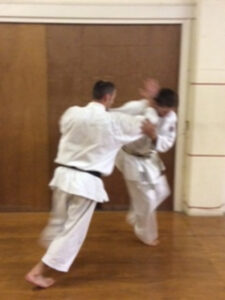Don’t give me any more lip!
 For those who have known me for more than 5 years could say I am being hypocritical here. However, after previously studying mainstream karate* for 26 years. Then 5 years ago moving to a logical, pragmatic approach with civilian self defence in mind. I believe I have good experience to present an opinion from both sides of the fence.
For those who have known me for more than 5 years could say I am being hypocritical here. However, after previously studying mainstream karate* for 26 years. Then 5 years ago moving to a logical, pragmatic approach with civilian self defence in mind. I believe I have good experience to present an opinion from both sides of the fence.
It has been very obvious to me over the past 5 years while intensely studying and practicing the practical approach to karate. How much “lip service” is given to certain element or training methods in karate.
For example:
- Things like telling the student “talk your way out it if you can” then never teach or practice verbal de-escalation.
- “Run away when you can” then never teach or practice running away or fighting to flee and escape to a safe zone. Or protecting another person.
- “You can hit first” then never teach the Law and how it supports a preemptive strike. Or practice when to preemptively strike while faced with aggressive, threatening or offensive language prior to an assault.
or
- “We practice Bunkai” (combative principles). This is a large area where many give lip service to the essential study and practice of combative principles found in kata. It is here I would like to offer the question, How do you divide your teaching or training time to kata?
Many karateka practicing a modern Japanese version of karate, will spend most of their kata practice on the solo form. The performance becomes the goal, missing out on the valuable and essential meaning and purpose of the kata they practice.
From the many years of studying mainstream karate. I can confidently say almost all the kata seminars I attended with top Instructor both Japanese and Western. Concentrated 80% to 90% of the class on the solo form and any bunkai would be relatively static with a karate v karate model. Never were the applications progressed to a live, chaotic practice.
If we follow the 4 stages of kata practice presented by Iain Abernethy, we can begin to calculate how much training time can be distributed to the 4 elements of kata.
The 4 stages are:
- Learn the solo form
- Learn the practical application of every move, in a proactive way and not karate v karate.
- Vary and adapt these applications using the same principles
- Gain experience in live practice.
Do the Maths!
If we give each of the 4 stages an equal amount of training time. 25% of each element would be practiced. From a practical approach an example of a 4 hour kata practice will give us:
1hr of solo form
3hr of partner work with an increasing degree of partner resistance and chaos.
However, from a mainstream approach a more common calculation would be:
3hr of solo work
1hr of partner work, usually using karate v karate techniques.
Using these calculations, we can clearly see a vast difference in actual physical contact with another person. This is very evident when I have students from mainstream dojo come and train with me. They are often uncomfortable with the closeness, physical resistance and chaos of our training methods. But this is quickly resolved following a few sessions and their practical understanding of the kata made clear.
My point is, many karateka state they teach or practice Bunkai (combative principles). But how much time do you dedicate to it and to what depth. More importantly is it a progressive model, which will provide you with the skills to apply it in a live, chaotic situation?
Stop giving these elements “Lip service” and misleading students to believe they are part of their training. I encourage you to seek out Information and Instruction, then provide your student or your own training with a logical, practical method to karate.
Happy studying.
* By mainstream I mean modern Japanese karate designed for sport / Do with movement, aesthetics and consensual sport sparring being the main emphasis

